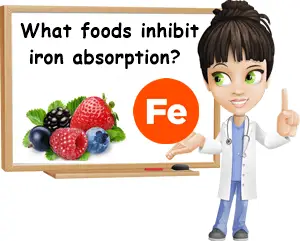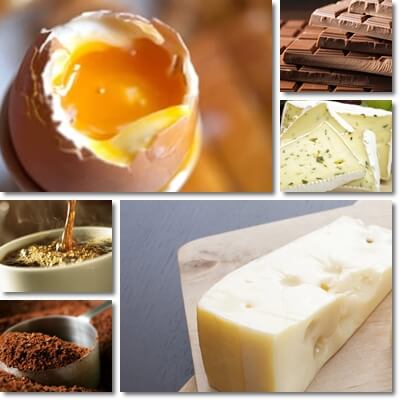Most people are looking to find out what foods to eat to increase their iron absorption in the blood in order to correct a deficiency of the mineral and associated symptoms such as weakness and fatigue. What most people aren’t looking to do is reduce their iron levels in the blood. Even so, there are instances when lowering iron levels is medically recommended, such as conditions that cause iron overload. In such cases, looking to eat foods that reduce iron absorption and subsequently also lower levels of the mineral in the blood represents a health-promoting approach.
Are there foods that reduce iron levels in the blood? Actually, there are. A lot of commonly available foods contain special compounds that lower iron levels in the blood such as dietary fiber, phytic acid, oxalates, tannins and other polyphenols, phosvitin, caffeine, theine and calcium and other dietary minerals. Foods containing high amounts of these compounds block iron absorption at the intestinal level and indirectly contribute to reducing levels of the mineral in the blood.

One important observation: most of these foods don’t just block iron absorption, but affect the uptake of other essential nutrients as well and can easily encourage multiple nutritional deficiencies. As a result, if you have been diagnosed with iron overload, the first step is to see your doctor to identify the cause behind the increased levels of the mineral in your blood. After that discuss with your doctor what the best course of action for you is, whether it’s getting on a low-iron diet, decreasing absorption of the mineral with the help with iron blocker foods or supplements or if other options are better suited to your situation.
Iron blocker foods
What foods inhibit iron absorption? Here is a detailed list of foods that have the potential to reduce the absorption of the mineral and subsequently also blood levels:
1) Calcium-rich foods. Calcium competes with iron for absorption, reducing uptake by up to 50% or 60% according to a study published in the European Journal of Clinical Nutrition. Drinking milk, eating cheese or fermented dairy products with main meals or taking a calcium supplement blocks iron absorption and can help achieve lower blood levels of the mineral over time.
Calcium-rich foods such as hard cheeses (Parmesan, Cheddar, Pecorino Romano, mozzarella, aged goat cheese, feta, provolone), but also milk (non-fat milk, reduced fat and regular, soured milk, buttermilk), yogurt, whey, dried whey and whey protein are some of the best iron-blocker foods to consider. Plant-based sources of calcium such as kale, almonds, sesame seeds, savory, marjoram, thyme, cinnamon and more may affect the absorption of not just iron, but also calcium and other essential nutrients due to them containing anti-nutrients such as phytic acid.

2) Egg yolk. According to studies, phosvitin, a protein in egg yolk inhibits iron absorption (even though egg yolk is a rich source of the mineral). The same protein has been found to reduce uptake of other minerals as well, notably calcium and magnesium. But there’s more to eggs and iron absorption. Eggs white have been found to help improve the absorption of the mineral from plant foods. Plant foods contain a form of iron called non-heme which is generally less bioavailable than the form in meat, eggs and dairy called heme.
3) Coffee or caffeinated teas (green tea, black tea). Caffeine in coffee and theine in green tea and black tea are iron absorption inhibitors, reducing uptake of the mineral. Not only this, but caffeine and theine reduce absorption of other dietary minerals as well such as magnesium and zinc. Having coffee with a main meal or right after can contribute to a lower iron count.
4) Tannins and other polyphenols. Tannins are naturally-occurring compounds in plant foods and their byproducts. They are astringent and cause your mouth to pucker. They are found in unripe persimmons, quinces, berries such as blackberries, blueberries, strawberries, cranberries, spices such as cinnamon and cloves, teas, wine, cocoa, coffee and chocolate and various herbs. Tannins bind to iron and reduce its absorption into the bloodstream.
5) Oxalic acid. Oxalic acid is a naturally-occurring compound found in leafy green vegetables such as spinach, sorrel, patience dock, monk’s-rhubarb, beet greens, broccoli, Brussels sprouts, rhubarb and star fruit (carambola). Oxalic acid binds to iron, calcium, magnesium, zinc and copper, potassium and phosphorus and inhibits absorption of the minerals.
6) Phytic acid. Phytic acid is a form of phosphorus that plants store. Studies show it binds to iron as well as calcium, magnesium and zinc and inhibits their absorption. Grains, especially whole grains, legumes such as beans, lentils and soybeans, raw nuts and seeds including peanuts, almonds, Brazil nuts, pumpkin seeds, sesame seeds, flaxseed, Chia seeds are all rich sources of phytic acid. To lower phytic acid content and reduce its mineral-binding properties, foods need to be cooked, soaked, sprouted or fermented.
7) Other minerals. Other minerals compete with iron for absorption into the bloodstream and can result in reduced blood levels of the latter. Minerals that compete for absorption include: calcium, magnesium, zinc and copper.
8) Dietary fiber. Dietary fiber is essentially indigestible plant material that is not assimilated in the same way as nutrients in food. High intakes however decrease the uptake of nutrients from food, including that of iron. Other dietary minerals, vitamins and cholesterol from food are further affected by a high intake of fiber.
9) Curcumin in turmeric. Curcumin is the biologically active compound in turmeric, responsible for the majority of the health benefits of the spice. Curcumin is a polyphenol with iron-chelating properties, meaning it binds to the mineral and helps eliminate it from the body. Studies show supplementation with curcumin successfully reduced iron overload in mice, but a 40% increase in spleen mass was also observed. These effects were obtained for curcumin doses higher than would normally be consumed from food.
Other ways to block iron absorption
Aside from eating foods that inhibit its absorption, you can further reduce blood levels of the mineral with the help of the following tips:
1) Lower iron intake by eating foods that are naturally low in the mineral.
2) Eat more plant foods – even though plenty of plant foods are a good source of the mineral, the form they contain is the non-heme type which is a less bioavailable form.
3) Reduce intake of foods high in the mineral such as: liver, pork, beef, veal, turkey, chicken, fish such as sardines or tuna, seafood such as oysters, blue mussels or octopus.
4) Avoid taking multivitamins that contain iron.
5) Read the label on foods and avoid those fortified with the mineral.
6) Avoid vitamin C supplements as vitamin C greatly increases absorption of the mineral.
7) Eat nuts and seeds raw. Avoid soaking them as this decreases their phytic acid content and reduces its mineral-binding properties.
8) Eliminate other potential sources of the mineral in your diet: pots and pans and check drinking water for levels of the mineral.
